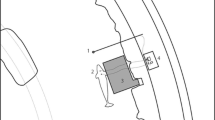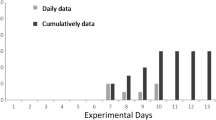Summary
Classical conditioning was employed to test the sensitivity of cephalopods to vibrations between 1 and 100 Hz generated in a standing wave acoustic tube. The animals were trained to associate sound stimuli with a weak electric shock, and the recorded conditioned responses were changes in breathing and jetting activity. Five specimens of Sepia officinalis were tested, and all responded to these low frequency sounds. The relevant stimulus parameter was particle motion rather than sound pressure. The threshold values (measured as particle acceleration) decreased towards lower frequencies in the tested range, reaching values below 4 × 10-3 m/s2. The thresholds in the most sensitive range may have been masked by the considerable background noise at the experimental site (Naples). Two individuals of Octopus vulgaris and one Loligo vulgaris were also tested, and showed a similar sensitivity to low frequency sound.
Similar content being viewed by others
References
Arnold JM, Williams-Arnold LD (1980) Development of the ciliature pattern on the embryo of the squid Loligo pealei: a scanning electron microscope study. Biol Bull 159:102–116
Budelmann B-U (1970) Die Arbeitsweise der Statolithenorgane von Octopus vulgaris. Z Vergl Physiol 70:278–312
Budelmann B-U (1976) Equilibrium receptor systems in molluscs. In: Mill PJ (ed) Structure and function of proprioceptors in the invertebrates. Chapman and Hall, London, pp 529–566
Budelmann B-U (1979) Hair cell polarization in the gravity receptor systems of the statocysts of the cephalopods Sepia officinalis and Loligo vulgaris. Brain Res 160:261–270
Budelmann B-U, Bleckmann H (1988) A lateral line analogue in cephalopods: water waves generate microphonic potentials in the epidermal head lines of Sepia and Lolliguncula. J Comp Physiol A 164:1–5
Budelmann B-U, Wolff HG (1973) Gravity response from angular acceleration receptors in Octopus vulgaris. J Comp Physiol 85:283–290
Chapman CJ, Hawkins AD (1973) A field study of hearing in the cod, Gadus morhua L. J Comp Physiol 85:147–167
Corner BD, Moore HT (1980) Field observations on the reproductive behavior of Sepia latimanus. Micronesica 16:235–260
Dijkgraaf S (1963) Versuche über Schallwahrnehmung bei Tintenfischen. Naturwissenschaften 50:50
Dixon WJ (1965) The up-and-down method for small samples. J Am Statist Ass 60:967–978
Hanlon RT, Budelmann B-U (1987) Why cephalopods are probably not “deaf”. Am Nat 129:312–317
Hanlon RT, Hixon RF, Hulet WH (1983) Survival, growth, and behavior of the loliginid squids Loligo plei, Loligo pealei, and Lolliguncula brevis (Mollusca: Cephalopoda) in closed sea water systems. Biol Bull 165:637–685
Hawkins AD, MacLennan DN (1976) An acoustic tank for hearing studies in fish. In: Schuijf A, Hawkins AD (eds) Sound reception in fish. Elsevier, Amsterdam, pp 149–169
Hubbard SJ (1960) Hearing and the octopus statocyst. J Exp Biol 37:845–853
Hulet WH (1982) Commentary on the international symposium on functional morphology of cephalopods. Malacologia 23:203–208
Moynihan M (1985) Why are cephalopods deaf? Am Nat 125:465–469
Moynihan M, Rodaniche AF (1982) The behavior and natural history of the Caribbean reef squid Sepioteuthis sepioidea. Advances in ethology 25. Paul Parey, Berlin
Norris KS, Møhl B (1983) Can odontocetes debilitate prey with sound? Am Nat 122:85–104
Packard A, Trueman ER (1974) Muscular activity of the mantle of Sepia and Loligo (Cephalopoda) during respiratory movements and jetting, and its physiological interpretation. J Exp Biol 61:411–419
Reid ML, Eckert CG, Muma KE (1986) Booming odontocetes and deaf cephalopods: putting the cart before the horse. Am Nat 128:438–439
Sand O (1981) The lateral-line and sound reception. In: Tavolga WN, Popper AN, Fay RR (eds) Hearing and sound communication in fishes. Springer, New York, pp 459–480
Sand O (1984) Lateral-line systems. In: Bolis L, Keynes RD, Maddrell SHP (eds) Comparative physiology of sensory systems. Cambridge University Press, Cambridge, pp 3–32
Sand O, Karlsen HE (1986) Detection of infrasound by the atlantic cod. J Exp Biol 125:197–204
Stephens PR, Young JZ (1982) The statocyst of the squid Loligo. J Zool Lond 197:241–266
Sundermann G (1983) The fine structure of epidermal lines on arms and head of postembryonic Sepia officinalis and Loligo vulgaris (Mollusca, Cephalopoda). Cell Tissue Res 232:669–677
Sundermann-Meister G (1978) Ein neuer Typ von Cilienzellen in der Haut von spätembryonalen und juvenilen Loligo vulgaris (Mollusca, Cephalopoda). Zool Jahrb Abt Anat Ontog Tiere 99:493–499
Taylor MA (1986) Stunning whales and deaf squids. Nature 323:298–299
Wells MJ (1978) Octopus: physiology and behaviour of an advanced invertebrate. Chapman and Hall, London
Wells MJ, Wells J (1956) Tactile discrimination and the behavior of blind Octopus. Pubbl Stn Zool Napoli 28:94–126
Williamson R (1988) Vibration sensitivity in the statocyst of the northern octopus. Eledone cirrosa. J Exp Biol 134:451–454
Williamson R, Budelmann B-U (1985) The response of the Octopus angular acceleration receptor system to sinusoidal stimulation. J Comp Physiol A 156:403–412
Young JZ (1960) The statocysts of Octopus vulgaris. Proc R Soc Lond B 152:3–29
Author information
Authors and Affiliations
Rights and permissions
About this article
Cite this article
Packard, A., Karlsen, H.E. & Sand, O. Low frequency hearing in cephalopods. J Comp Physiol A 166, 501–505 (1990). https://doi.org/10.1007/BF00192020
Accepted:
Issue Date:
DOI: https://doi.org/10.1007/BF00192020




